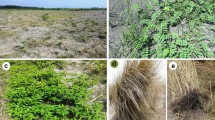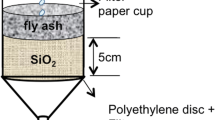Abstract
Heavy metal content of high load ashes applied on the ground during severe forest fires may be released into rainwater, and through it, they can either penetrate into the ground water or be washed out into water receivers, causing a severe environmental problem. The chemical composition of two dominant Greek forest species (Pinus halepensis, Quercus coccifera) ashes was determined before and after leaching. The ash samples were similar to those obtained in actual forest fires and two leaching tests (column and shake leaching test) were employed using aqueous solutions of pH = 6 and 1. For the analysis of ashes (prior to and after leaching), the following analytical techniques were used: X-ray diffraction and scanning electron microscopy with energy dispersive X-ray analysis. For the analysis of leachates ion chromatography and inductively coupled plasma emission spectrometry were used. At pH = 6 (rainwater conditions) some elements were released (i.e., 95% Cr, 70% Pb). The release of Cr is up to 95% for P. halepensis and 76% for Q. coccifera. The total amount of some toxic elements recovered (i.e., Cd) was up to 99%. As expected, at pH = 1 the majority of metallic elements were almost completely recovered. Knowledge of the leaching properties of Mediterranean forest species ashes is very important for evaluating their impact on the environment (soil and ground and underground water streams).




Similar content being viewed by others
References
ASTM D1102–84. (2001). Standard Test Method for Ash in Wood.
Campbell, A. G. (1990). Recycling and disposing of wood ash. Tappi Journal, 73, 141–145.
Certini, G. (2005). Effects of fire on properties of forest soils: a review. Oecologia, 143, 1–10. doi:10.1007/s00442-004-1788-8.
Clapham, W. M., & Zibilske, L. M. (1992). Wood ash as a liming amendment. Communications in Soil Science and Plant Analysis, 23, 1209–1227. doi:10.1080/00103629209368661.
Demeyer, A., Voundi Nkana, J. C., & Verloo, M. G. (2001). Characteristics of wood ash and influence on soil properties and nutrient uptake: an overview. Bioresource Technology, 77, 287–295. doi:10.1016/S0960-8524(00)00043-2.
Dimitrakopoulos, A. P., & Panov, P. I. (2001). Pyric properties of some Mediterranean vegetation species. International Journal of Wildland Fire, 10, 23–27. doi:10.1071/WF01003.
DIN 38 414, Teil 4. (1984). Bestimmung der Eluierbarkeit mit Wasser (S4). Deutsch Einheitsverfahren zur Wasser-, Abwasser- und Schlammuntersuchung. Schlamm und Sedimente (Gruppe S.).
Erich, M. S., & Ohno, T. (1992). Titrimetric determination of calcium carbonate equivalence of wood ash. Analyst (London), 117, 993–995. doi:10.1039/an9921700993.
Etiegni, L., & Campbell, A. G. (1991). Physical and chemical characteristics of wood ash. Bioresource Technology, 37, 173–178. doi:10.1016/0960-8524(91)90207-Z.
Etiegni, L., Campbell, A. G., & Mahler, R. L. (1991a). Evaluation of wood ash disposal on agricultural land. I. Potential as a soil additive and liming agent. Communications in Soil Science and Plant Analysis,, 22, 243–256. doi:10.1080/00103629109368412.
Etiegni, L., Mahler, R. L., Campbell, A. G., & Shafii, B. (1991b). Evaluation of wood ash disposal on agricultural land. II. Potential toxic effects on plant growth.. Communications in Soil Science and Plant Analysis, 22, 257–267. doi:10.1080/00103629109368413.
European Directive. 1976. 76/464/EEC.
Fallman, A. M., & Aurell, B. (1996). Leaching tests for environmental assessment of inorganic substances in wastes, Sweden. The Science of the Total Environment, 178, 71–84. doi:10.1016/0048-9697(95)04799-9.
Hage, J. L. T., & Mulder, E. (2004). Preliminary assessment of three new European leaching tests. Waste Management (New York, N.Y.), 24, 165–172. doi:10.1016/S0956-053X(03)00129-6.
Huang, H., Campbell, A. G., Folk, R., & Mahler, R. L. (1992). Wood ash as a soil additive and liming agent for wheat. Field studies. Communications in Soil Science and Plant Analysis, 23, 25–33. doi:10.1080/00103629209368567.
Lerner, R. B., & Utzinger, J. D. (1986). Wood ash as soil liming material. HortScience, 21, 76–78.
Liodakis, S., Katsigiannis, G., & Kakali, G. (2005). Ash properties of some dominant Greek forest species. Thermochimica Acta, 437, 158–167. doi:10.1016/j.tca.2005.06.041.
Liodakis, S., Gakis, D., Ahlovist, K., & Statheropoulos, M. (2004). Pyrolysis of Pinus halepensis needles treated with fire retardants. Annals of Forest Science, 61, 551–555. doi:10.1051/forest:2004050.
Ludwig, B., Khanna, P., Prenzel, J., & Beese, F. (2005). Heavy metal release from different ashes during serial batch tests using water and acid. Waste Management (New York, N.Y.), 25, 1055. 1066. doi:10.1016/j.wasman.2005.01.007.
Misra, M. K., Ragland, K. W., & Baker, A. J. (1993). Wood ash composition as a function of furnace temperature. Biomass and Bioenergy, 4, 103–116. doi:10.1016/0961-9534(93)90032-Y.
Mukherji, S. K., Dan, T. K., & Machhoya, B. B. (1995). Characterization and utilization of wood ash in the ceramic industry. Interceram, 44, 31–33.
Naylor, L. M., & Schmidt, E. J. (1986). Agricultural use of wood ash as a fertilizer and liming material. Tappi Journal, 69, 114–119.
Nurmi, J., & Hillebrand, K. (2007). The characteristics of whole-tree fuel stocks from silvicultural cleanings and thinnings. Biomass and Bioenergy, 31, 381–392. doi:10.1016/j.biombioe.2007.01.010.
Resource, C., & Act, R.(RCRA), US Code 42, Chapter 82, Subtitle C, 1976.
Ramesh, A., & Kozinski, J. A. (2001). Investigations of ash topography/morphology and their relationship with heavy metals leachability. Environmental Pollution, 111, 255–262. doi:10.1016/S0269-7491(00)00062-2.
Reijnders, L. (2005). Disposal, uses and treatments of combustion ashes: a review. Resources, Conservation and Recycling, 43, 313–336. doi:10.1016/j.resconrec.2004.06.007.
Saikia, N., Kato, S., & Kojima, T. (2006). Composition and leaching behaviours of combustion residues. Fuel, 85, 264–271. doi:10.1016/j.fuel.2005.03.035.
Shin, H. W., Sidharthan, M., & Young, K. S. (2002). Forest fire ash impact on micro- and macroalgae in the receiving waters of the east coast of South Korea. Marine Pollution Bulletin, 45, 203–209. doi:10.1016/S0025-326X(02)00156-X.
Ulery, A. L., Graham, R. C., & Amrhein, C. (1993). Wood ash composition and soil pH following intense burning.. Soil Science, 156, 358–364. doi:10.1097/00010694-199311000-00008.
Voundi Nkana, J. C., Demeyer, A., & Verloo, M. G. (1998). Chemical effects of wood ash on plant growth in tropical acid soils.. Bioresource Technology, 63, 251. doi:10.1016/S0960-8524(97)00134-X.
Acknowledgements
The authors acknowledge the Operational Program for Educational and Vocational Training II (EPEAEK II) and particularly the Program PYTHAGORAS, for financially supporting the work. The project is cofunded by the European Social Fund (75%) and National Resources (25%).
Author information
Authors and Affiliations
Corresponding author
Rights and permissions
About this article
Cite this article
Liodakis, S., Tsoukala, M. & Katsigiannis, G. Laboratory Study of Leaching Properties of Mediterranean Forest Species Ashes. Water Air Soil Pollut 203, 99–107 (2009). https://doi.org/10.1007/s11270-009-9994-y
Received:
Accepted:
Published:
Issue Date:
DOI: https://doi.org/10.1007/s11270-009-9994-y




